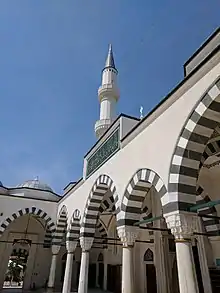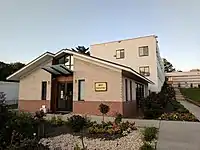Islam in Maryland
There are around 70,000 Muslims in Maryland in the United States as of December 1992, according to the American Muslim Council. This is the tenth highest number of Muslims of all U.S. states, representing 1.4% of the Muslim population in the country, as well as 1.4% of the total population of Maryland, at the time of the report.[1]


History
Baltimore has had a Muslim community as far back as 1943. Masjid Ul-Haqq was established as a Nation of Islam mosque in 1947, on Ensor Street. The congregation later moved to 1000 Pennsylvania Avenue. The mosque was known as Mosque Six. The mosque moved to 514 Wilson Street in the late 1950s, where it is currently located. Nation of Islam leader Elijah Muhammad spoke at the mosque in 1960 to over a thousand people. After the death of Muhammad in 1975, the mosque's congregants converted to Sunni Islam and it became known as Masjid Ul-Haqq.[2][3]
In 1979, the number of Muslims in Baltimore and its suburbs was estimated to be 3,000–5,000 by Islamic Society of Baltimore co-founder Dr. Mohamed Z. Awad.[4]
As reported by The Baltimore Sun, in 1983, the number of Muslims in Baltimore was estimated to be several thousand.[5] In 1985, the number was estimated the number to be around 15,000, as well as 40,000 Muslims living in the Baltimore–Washington region.[6]
In 1995, Maqbool Patel, the president of the Islamic Society of Baltimore, estimated the number of active Muslim families in the state to be 5,000, with 1,500 being in the Baltimore area.[7]
As of 2000, it is estimated that Frederick County has 200 Muslim families.[8] In 2000, the Islamic Society of Frederick planned the construction of a mosque along with a Muslim cemetery, which would be the first mosque in Frederick County and the first Muslim cemetery in Maryland. The land they wanted to build the mosque on, however, was off-limits for development, and their appeal to the county commissioners to connect to the county water and sewer lines was met with a tie vote, barring their ability to build a mosque.[9]
Mosques
- Baitur Rehman Mosque, an Ahmadiyya mosque in Silver Spring.
- Masjid Us Salaam a mosque in downtown Baltimore.
- Diyanet Center of America, a mosque and Muslim community center in Lanham.
- Imam Mahdi Islamic Education Center of Baltimore, a mosque and Islamic education center in Baltimore.
- Islamic Society of Baltimore, serves around 3,000 people, site of former president Barack Obama's first presidential visit to a U.S. mosque.
- Islamic Society of Western Maryland, a mosque in Hagerstown.
References
- Numan, Fareed H. (December 1992). "A Brief Statement". American Muslim Council. Retrieved September 20, 2018.
- "Masjid Ul-Haqq". Baltimore Heritage. December 11, 2017. Retrieved March 10, 2020.
- Rola Ghannam (January 8, 2018). "As Masjid Founders Pass Away, So Does Community History". Community News. The Muslim Link. Archived from the original on May 23, 2019.
- Somerville, Frank P. L. (November 30, 1979). "Call to ring bells to support hostages gets discordant echoes from clergy". The Baltimore Sun. Retrieved March 16, 2020.
- Somerville, Frank P. L. (April 24, 1983). "Pratt's Islamic programs touch a nerve in Muslim community". The Baltimore Sun. Retrieved January 21, 2020.
- Somerville, Frank P. L. (June 21, 1985). "Local Muslims celebrate end of month-long Ramadan fast". The Baltimore Sun. Retrieved January 18, 2020.
- Elaine, Tassy (February 27, 1995). "Children fast for Ramadan". The Baltimore Sun. Retrieved March 8, 2020.
- Daemmrich, JoAnna (August 25, 2000). "Frederick's Muslims make plea for mosque". The Baltimore Sun. Retrieved March 9, 2020.
- Daemmrich, JoAnna (August 24, 2000). "Hopes for Frederick mosque stir debate". The Baltimore Sun. Retrieved March 10, 2020.